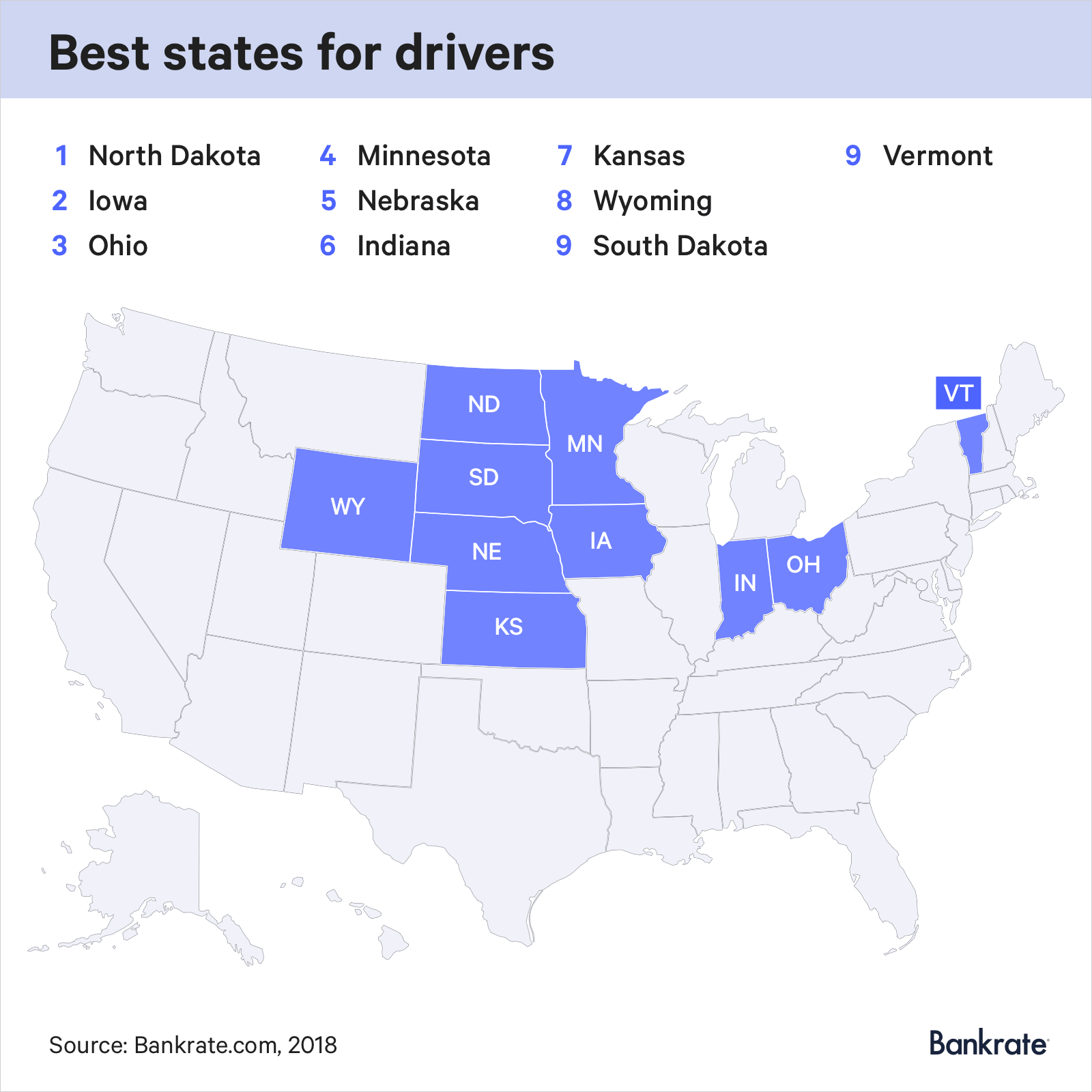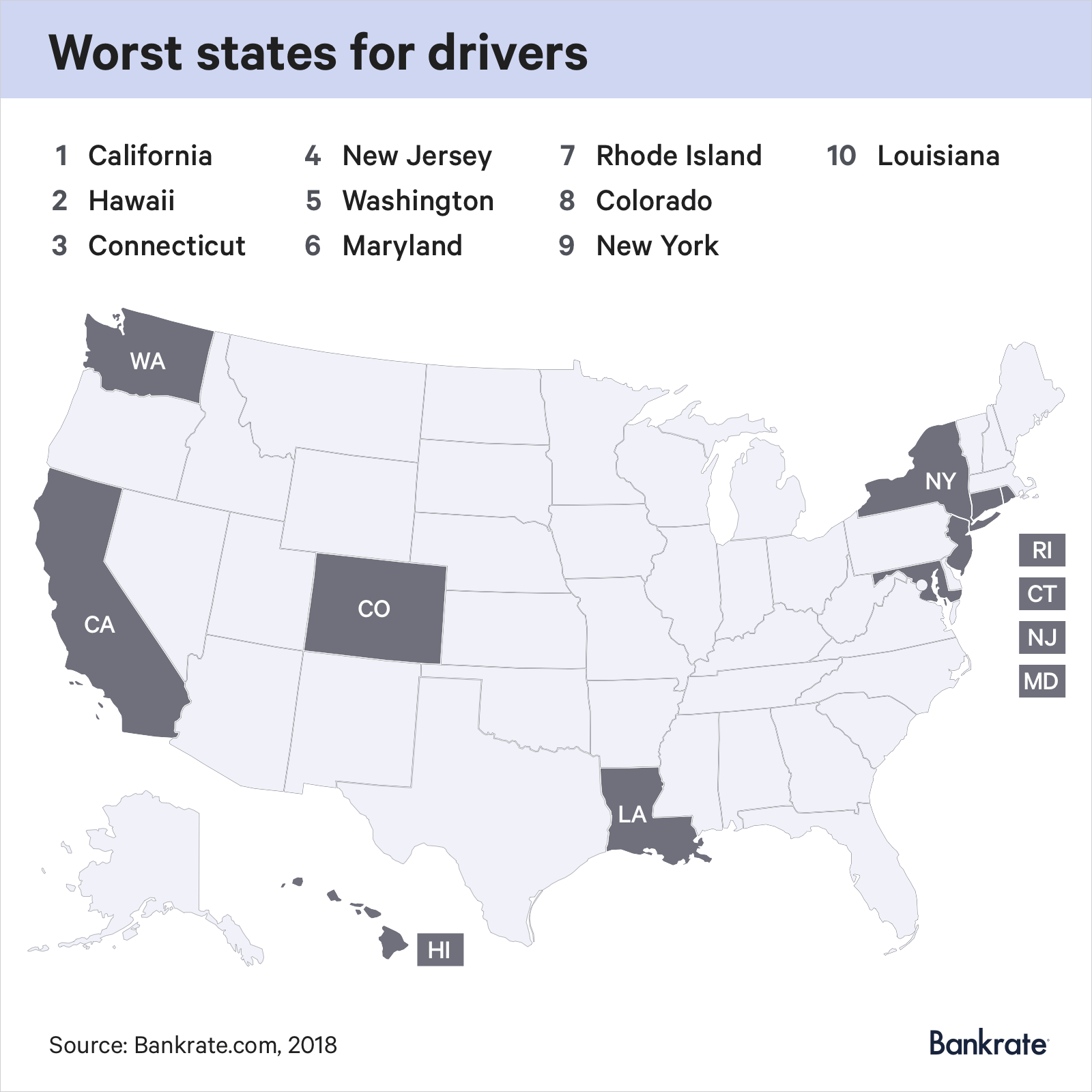The best and worst states for drivers, ranked
by Adrian D Garcia, BankRate.com,December 5, 2018
Getting behind the wheel can be a peaceful experience for Americans rolling across open roads in the Great Plains and Midwest, while drivers near the coasts are more likely to be sitting in traffic.
North Dakota slides into the top spot when it comes to states that are affordable, safe and reliable for drivers, according to the 2018 Bankrate Best States for Drivers Study. The Rough Rider State is followed by Iowa, Ohio, Minnesota and Nebraska as states that tend to be convenient, safe and affordable for drivers.
California is the worst place for drivers, just behind Hawaii, Connecticut, New Jersey and Washington, according to the study.
Owning a vehicle impacts budgets differently depending on where a person lives. Long waits and poor maintained roads cost drivers more time and money in addition to the expenses they already incur from regular maintenance of their vehicles, experts say.
“Certainly, here in the Bay Area there’s a lot to complain about with regards to most people’s commutes,” says John Goodwin, spokesman for the Metropolitan Transportation Commission and Bay Area Toll Authority.
“I drive a fair bit and my advice to everybody is be safe and be patient. You’ll get there,” Smith says. “Don’t let it stress you out. Exercise patience, and take advantage of the openings when they’re there.”
The average commute time in California is nearly half an hour. Still, most Californians drive solo on their way to work. They’re not alone. More than three-quarters of commuters in the United States — 117 million people — are getting to work by driving themselves, according to the latest numbers from the U.S. Census Bureau.
For the 2018 Bankrate Best States for Drivers Study, we looked at seven measures related to cost, safety and driving quality including commute time information, traffic fatality data, road condition reports and gas prices.
The best states for drivers
North Dakota is fairly safe for drivers, with a fatality rate of 1.16 deaths per 100 million vehicle miles traveled and a theft rate of 234.7 vehicles per 100,000 inhabitants — lower traffic fatality and vehicle theft rates than the national averages. The state also tends to be cheaper for drivers with lower gas prices, repair and maintenance costs and an average insurance vehicle premium of $1,086 compared with the $1,365 people typically pay nationally, according to Insure.com.
Better still, the average commute time in North Dakota is about 18 minutes, and just 10 percent of roads are in poor condition, according to the Bankrate study.

Michelle Halone, an accounting budget specialist at the North Dakota Department of Commerce, spends 30 to 40 minutes riding to and from her home in rural Oliver County to her office in Bismarck. While she may have to stop and wait for the occasional wildlife to cross or deal with the seasonal snowstorm, there’s not much in the way of congestion.
“I get to gear up for the day on the way to work, and on the way home I get to wind down from the day,” Halone says, “so it’s really not that bad. I get to get in the right frame of mind and see nice sunrises.”
Farther east, Brad Murchie depends on good road conditions in and around Fargo to successfully operate his private luxury car service Noir 8. Even Fargo, a city of 122,000 residents, gets its rush hours as people head home from work, Murchie says, but it’s a breeze compared to Chicago where he previously lived.
“The joke around Fargo, because it’s so small is everything is 10 minutes away,” he says. “And that’s fairly accurate. You can get anywhere in 10 minutes if traffic and weather are good.”
The worst states for drivers
Goodwin and Alison Inconstanti regularly face the iconic California traffic nightmare. Inconstanti works in the touring department for a movie studio in Culver City and lives in the Tarzana neighborhood of Los Angeles. Her commute would take about 20 minutes if there was no traffic, she says. But since she lives in L.A., there’s usually traffic and getting to her job takes about an hour — maybe longer.
“It means I get up earlier,” Inconstanti says. “A lot of my nine-hour workdays are really 11 hours with the commute. … It’s just part of the cost of being in this town, which I really love being in.”

Goodwin parks in Oakland and rides public transit into San Francisco. He says he and others are facing tougher commutes than in other communities because people cannot afford to live near where they work.
“Over the course of the last 70-plus years, we have developed two really big job centers in our region: San Francisco proper and Silicon Valley,” he says. “Both are notoriously expensive places to live, so most of the housing development has been built far away from San Francisco and Silicon Valley.”
It’s not just long wait times; 44 percent of roads in the Golden State are in poor condition, double the nationwide total of 22 percent, according to the transportation research nonprofit TRIP. California also has more thefts as well as higher insurance premiums, repair costs and gas prices than the national averages, according to the Bankrate study.
The cost of owning a car
People have been more apt to get behind the wheel in recent years as we’ve moved away from the Great Recession and prices at the pump became cheaper. Investment in transportation enhancement and improvements is not keeping up with the uptick in congestion in many areas, says Rocky Moretti, director of policy and research for TRIP.
“As roads deteriorate, you’re going to have additional routine repairs,” Moretti says. “If you look at the national number, we estimate that additional cost of driving on rough roads is $599 annually — $130 billion nationally.”
Many drivers don’t think about all the extra costs that go along with automobile ownership before driving their vehicle off the sales lot, says Mark Hamrick, senior economic analyst at Bankrate.
“Our Bankrate surveys have indicated the failure to save for emergencies and retirement rank top among financial regrets. All of us who have owned an automobile in our lives know at some level there are very expensive events related to car ownership, whether it’s a maintenance cost or repair costs,” Hamrick says. “The only way to prepare for all of that is to have some emergency savings.”
Drivers in California, North Dakota and other states would benefit from stashing cash away in a savings account with a strong interest rate so when they get a flat tire, are involved in a fender bender or unexpectedly find themselves needing money for another reason, it’s there. Commuters might also benefit from considering hybrid or fuel-efficient vehicles, using carpools or alternative transportation if possible, shopping around for insurance and seeing if their employer or metro offers transportation benefit programs and incentives.
Relief may be on the way for those who will continue to drive, Moretti says. Even troubled California earmarked billions of dollars to improve roads and improve traffic safety across the state in 2017 — a move voters overwhelmingly upheld in November.
“Twenty-seven states have moved forward with significant funding packages since 2013, and we feel that’s a recognition the ongoing deterioration of roads and bridges,” he says. “We’re going to see an increasing mix of possibilities, particularly in urban transportation. If we’re willing to invest adequately in our transportation improvement we’ll certainly see further improvements in mobility.”
read … Full Report